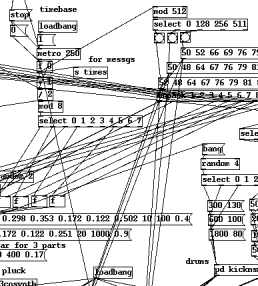Difference between revisions of "Pure Data"
Jump to navigation
Jump to search
| Line 1: | Line 1: | ||
[[Image:Pure_Data_screenshot.png|thumb|258px|]] | [[Image:Pure_Data_screenshot.png|thumb|258px|]] | ||
| − | '''Pure Data''' ( | + | '''Pure Data''' (or '''Pd''') is a real-time graphical programming environment for audio, video, and graphical processing. Pure Data is commonly used for live music performance, [[VJing]], sound effects, composition, audio analysis, interfacing with sensors, using cameras, controlling robots or even interacting with websites. Because all of these various media are handled as digital data within the program, many fascinating opportunities for cross-synthesis between them exist. Sound can be used to manipulate video, which could then be streamed over the internet to another computer which might analyze that video and use it to control a motor-driven installation. [http://en.flossmanuals.net/pure-data/ (Source)] |
==Pages== | ==Pages== | ||
| Line 17: | Line 17: | ||
==Publications== | ==Publications== | ||
| − | * [http://monoskop.org/log/?tag=pure-data Publications | + | * Fränk Zimmer (ed.), ''[http://monoskop.org/log/?p=178 bang. Pure Data]'', Hofheim: Wolke, 2006, 175 pp. |
| + | * ''[http://en.flossmanuals.net/pure-data/ FLOSS Manuals: Pure Data]'', 2006–. | ||
| + | * [http://monoskop.org/log/?tag=pure-data Publications on Pure Data at Monoskop Log] | ||
==See also== | ==See also== | ||
Revision as of 21:52, 29 August 2014
Pure Data (or Pd) is a real-time graphical programming environment for audio, video, and graphical processing. Pure Data is commonly used for live music performance, VJing, sound effects, composition, audio analysis, interfacing with sensors, using cameras, controlling robots or even interacting with websites. Because all of these various media are handled as digital data within the program, many fascinating opportunities for cross-synthesis between them exist. Sound can be used to manipulate video, which could then be streamed over the internet to another computer which might analyze that video and use it to control a motor-driven installation. (Source)
Pages
Resources
Publications
- Fränk Zimmer (ed.), bang. Pure Data, Hofheim: Wolke, 2006, 175 pp.
- FLOSS Manuals: Pure Data, 2006–.
- Publications on Pure Data at Monoskop Log
See also
SuperCollider, Max/MSP, Sound art, FLOSS
